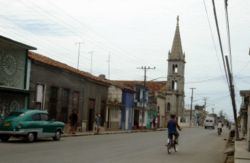Established 1859 Time zone EST (UTC-6) Elevation 10 m Population 136,722 (2010) Local time Tuesday 4:02 PM | Founded 1828 Demonym(s) Cardenense Area code(s) +53 45 Area 577.9 km² Postal code 42110 | |
 | ||
Weather 27°C, Wind NE at 34 km/h, 53% Humidity | ||
Cárdenas ([ˈkaɾðenas]), Calle Calzada Cárdenas is a municipality and city in the Matanzas Province of Cuba, about 116 km (72 mi) by air [156 km (97 mi) by road] east of Havana. Cárdenas is the 15th most-populated Cuban city and the second most populated one not being a provincial seat, after Manzanillo.
Contents
Map of Cardenas, Cuba
Geography
Cárdenas is a maritime port town on the level and somewhat marshy shore of a spacious bay of the northern coast of the island (Bay of Cárdenas), sheltered by a long promontory (Hicacos peninsula, including the Varadero beach resort). The city lies between the sea and hills.
A large quantity of asphalt has been taken from the bed of the harbour. A flow of fresh water from the bed of the harbour is another peculiar feature; it presumably comes from the outlets of subterranean rivers.
There are mostly narrow streets, various squares (including the Plaza de Colón, with a bronze statue of Columbus given to the city by Queen Isabella II. and erected in 1862) and substantial and elegant business and public buildings, including the ornate parish church designed by Architect Rafael Carrerá, who also built the famous Palacio Aldama in Central Havana.
The city is divided into the barrios of Cantel, Fundición, Guásimas, Marina, Méndez Capote, Pueblo Nuevo and Versalles.
The world-famous beach resort of "Varadero" is part of the Municipality of Cárdenas.
History
Cárdenas was founded in 1828, with the help of several old aristocratic Spanish-Cuban families from the nearby provincial capital of Matanzas and in 1861 already had 12,910 inhabitants. The completion of the railroad in 1841 led to further development. Cárdenas was one of the first cities in Cuba to have electric service, public transportation (trams), telegraph and telephone.
The city was peculiar in not being laid out in the traditional central-plaza Spanish custom, but rather, inspired on a North American perpendicular grid pattern, modeled on the city of Charleston, South Carolina, with the help of American (Confederate) landscape engineers.
In 1850, the Venezuelan General Narciso López, along with some Americans and Cuban exiles, landed here on a filibustering expedition, and held the town for a few hours, abandoning it when he saw that the people would not rise to support him in his efforts to secure Cuban independence. López did, however, raised for first time the modern Flag of Cuba designed by him along with a local Cuban Miguel Teurbe Tolon.
In May 1898, during the Spanish–American War, three notable battles were fought at Cardenas. However, credit for the republican victories goes mainly to the local Cuban patriot forces, led, among others, by General Carlos M. de Rojas (see below).
In the late 19th century and early 20th Century, Cárdenas was one of the main sugar-exporting towns of Cuba, and had received a great influx of European immigrants, including from Ireland, France, Italy and Corsica - many Cárdenas families were known for having foreign-sounding surnames, such as Jones, Larrieu, Smith, Villa-Giorgi and Sterling, among others.
By 1907 the population was 24,280. The shallowness of the harbour necessitated lighterage and repeated loading of cargoes. The surrounding region is farmed for its fertility.
The Cuban Flag was first raised over Cuban soil in this once picturesque, genteel and historic city of straight and narrow streets (the "Charleston of the Caribbean"), horse-drawn carriages, industry and "cangrejos" (blue crabs).
Cárdenas is also the home of the famous Elián González, a child at the centre of a political controversy between Cuba and the United States in 2000.
Demographics
In 2007, the municipality of Cárdenas had a population of 103,087. With a total area of 566 km2 (219 sq mi), it has a population density of 182.1/km2 (472/sq mi). Cardenas experiences a population growth of 0.24% a year.
